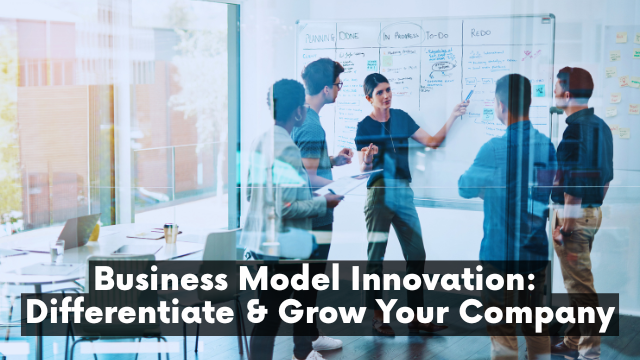In the competitive landscape of 2025, standing out isn’t just a goal—it’s survival. Business model innovation is the key to differentiating your company, capturing market share, and driving sustainable growth. Unlike product tweaks, it redefines how you create, deliver, and capture value. Whether you’re a startup carving a niche or an established firm seeking reinvention, this article offers actionable strategies to innovate your business model and thrive. Let’s explore how to rethink, reshape, and grow.
Why Innovate Your Business Model?
A stale model invites disruption. In 2025, customer expectations—think instant, personalized, sustainable—shift faster than ever. Innovation lets you meet those demands while outpacing rivals. It’s not about new products alone; it’s about new ways to profit. A traditional retailer might pivot to subscriptions; a tech firm could bundle services for recurring revenue. Reinventing your model fuels differentiation and growth.
Understand Your Current Model
Before innovating, map what you do now. In 2025, break it down: Who’s your customer? What value do you offer? How do you deliver and monetize it? A coffee shop might serve locals with premium drinks, sold per cup via a storefront. Use a tool like the Business Model Canvas (free online) to visualize—customer segments, revenue streams, cost structure. Clarity reveals what’s ripe for change.
Tap Into Customer Pain Points
Innovation starts with listening. In 2025, dig into what frustrates your audience—surveys, X conversations, or reviews on platforms like Yelp. A B2B software firm might hear “too complex”; a retailer could spot “slow shipping.” Address these creatively—simplify your UI or offer same-day delivery. Solving real problems sets you apart, turning complaints into loyalty and growth.
Experiment with Revenue Models
Your income engine can evolve. In 2025, test alternatives to one-off sales. A gym might shift from drop-in fees to a subscription for classes and virtual workouts. A SaaS startup could add a freemium tier to hook users, upselling premium features. Try pay-per-use, licensing, or even ads if it fits—think a free app monetized by sponsors. New streams stabilize cash flow and attract diverse customers.
Rethink Delivery Channels
How you reach customers can redefine your edge. In 2025, go beyond traditional paths. A local bakery might add a delivery app, tapping busy professionals. A tech firm could sell direct via webinars instead of costly trade shows. Explore social platforms—TikTok for Gen Z, LinkedIn for execs—or marketplaces like Amazon. Smarter channels cut costs and widen your net.
Leverage Technology for Scale
Tech is your innovation ally in 2025. Automate to save time—Zapier for workflows, AI chatbots for support. A small retailer could use AR to let shoppers “try” clothes online, boosting sales. A service firm might integrate blockchain for transparent billing, winning trust. Pick tools that align with your goals—start cheap with free trials. Tech-driven models scale faster and cheaper.
Build Ecosystems, Not Silos
Solo wins are short-lived. In 2025, create value through partnerships. A fitness startup might bundle wearables, apps, and nutrition plans with other brands, offering a one-stop wellness hub. A tech company could open its API, letting developers build on your platform—like Shopify’s app store. Ecosystems lock in customers and create network effects, fueling exponential growth.
Prioritize Sustainability
Green is gold in 2025. Innovate by embedding eco-conscious practices—consumers and investors reward it. A fashion brand might adopt a rental model, reducing waste while earning recurring fees. A manufacturer could switch to renewable energy, cutting costs long-term. Highlight your efforts—post on X or your site. Sustainable models attract wallets and goodwill, setting you apart.
Test and Iterate Fast
Innovation isn’t a one-shot deal. In 2025, launch small pilots—a pop-up subscription for your product, a new channel like Instagram Shop. Track results—sales, feedback, costs—using Google Analytics or a simple spreadsheet. A café testing meal kits might tweak recipes after reviews. Fail fast, learn quick, and scale what works. Iteration turns ideas into impact.
Foster an Innovation Culture
Your team drives the change. In 2025, encourage big thinking—reward ideas with shoutouts or bonuses. Hold brainstorming sessions; a junior staffer might spot a game-changer. Train on trends—AI, sustainability—via free webinars. A startup with open dialogue pivots faster; a small business stays nimble. Culture fuels innovation as much as strategy.
Measure Your Impact
Growth needs proof. In 2025, track metrics tied to your new model—revenue growth, customer retention, cost savings. A subscription shift might boost MRR 15%; a channel change could cut acquisition costs. Use tools like QuickBooks for financials, Mixpanel for user data. Clear wins—say, 20% profit jump—guide scaling and rally your team.
Conclusion
Business model innovation in 2025 is your ticket to stand out and scale. Listen to customers, rethink revenue and delivery, and leverage tech and partnerships. Test fast, iterate smart, and embed sustainability to win hearts and profits. It’s not about copying rivals—it’s about redefining value. Start innovating today, and watch your company grow like never before.
Frequently Asked Question About Differentiate & Grow Your Company
Q1: What is business model innovation?
Answer: It’s reimagining how your company creates, delivers, and captures value—think new revenue streams or delivery methods.
Q2: How can startups innovate with limited resources?
Answer: Start small—test a new pricing model or channel with a pilot, using free tools like Google Sheets to track.
Q3: Why is sustainability key to innovation in 2025?
Answer: It attracts eco-conscious customers, cuts costs, and builds brand loyalty, driving long-term growth.
Q4: How do I know if my new model is working?
Answer: Measure revenue, customer retention, and costs—tools like QuickBooks or analytics show what’s clicking.
Q5: What’s a common mistake in model innovation?
Answer: Overcomplicating—keep changes simple, test them, and scale only what delivers real results.








